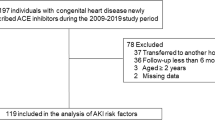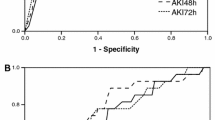Abstract
Children with congenital heart disease who undergo cardiac surgery are vulnerable to acute kidney injury (AKI). This study sought to evaluate the role of angiotensin-converting enzyme (ACE) inhibitors and other nephrotoxic medications in the risk for the development of AKI in neonates and children undergoing cardiac surgery. A retrospective review of all patients younger than 2 years admitted to the cardiac intensive care unit after cardiac surgery from March 2007 to September 2008 was conducted. Patients were included in the review if they received furosemide alone or in combination with an ACE inhibitor. Creatinine clearance was calculated, and the patient’s maximal degree of AKI was classified by pRIFLE. A P value less than 0.05 was considered significant. Of the 319 patients who met the inclusion criteria, 149 (47%) received furosemide therapy alone and 170 (53%) received a combination of furosemide and an ACE inhibitor. Patients in the furosemide-only group (age, 5 months) were older than the patients who received both furosemide and an ACE inhibitor (age, 3.8 months; P = 0.024). Despite statistically higher Aristotle scores in the ACE-inhibitor group, the intraoperative variables did not differ between the two groups. Postoperatively, the ACE-inhibitor group had a decreased creatinine clearance (55.3 ml/min/1.73 m2) compared with the furosemide group (64.4 ml/min/1.73 m2; P = 0.015) and an increased incidence of a pRIFLE maximal score of “F” (odds ratio [OR], 1.75; P = 0.033). However, after adjustment for additional risk factors, no difference in the occurrence of AKI resulted (OR, 0.939; P = 0.85) when patients received an ACE inhibitor. More than half of the study population received ACE inhibitors, but this treatment was not associated with an increase in AKI.

Similar content being viewed by others
References
Agras P, Derbent M, Ozcay F et al (2005) Effect of congenital heart disease on renal function in childhood. Nephron Physiol 99:10–15
Ahmed A (2002) Use of angiotensin-converting enzyme inhibitors in patients with heart failure and renal insufficiency: how concerned should we be by the rise in serum creatinine? J Am Geriatr Soc 50:1297–1300
Akcan-Arikan A, Zappitelli M, Loftis L, Washburn K, Jefferson L, Goldstein S (2007) Modified RIFLE criteria in critically ill children with acute kidney injury. Kidney Int 71:1028–1035
Bakris G, Weir M (2000) Angiotensin-converting enzyme inhibitor-associated elevations in serum creatinine: is this a cause for concern? Arch Intern Med 160:685–693
Bellomo R, Ronco C, Kellum J, Mehta R, Palevsky P (2004) Acute renal failure: definition, outcome measures, animal models, fluid therapy, and information technology needs: the Second International Consensus Conference of the Acute Dialysis Quality Initiative (ADQI) Group. Crit Care Med 8:R204–R212
Bellomo R, Auriemma S, Fabbri A et al (2008) The pathophysiology of cardiac surgery-associated acute kidney injury (CSA-AKI). Int J Artif Organs 31:166–178
Benedetto U, Sciarretta S, Roscitano A, Fiorani B, Refice S, Angeloni E, Sinatra R (2008) Preoperative angiotension-converting enzyme inhibitors and acute kidney injury after coronary artery bypass grafting. Ann Thorac Surg 86:1160–1165
Dent CL, Ma Q, Dastrala S et al (2007) Plasma neutrophil gelatinase-associated lipocalin predicts acute kidney injury, morbidity, and mortality after pediatric cardiac surgery: a prospective uncontrolled cohort study. Crit Care 11:R127
Dittrich S, Kurschat K, Dähnert I, Vogel M, Müller C, Alexi-Meskishvili V, Lange PE (2000) Renal function after cardiopulmonary bypass surgery in cyanotic congenital heart disease. Int J Cardiol 73:173–179
Gantenbein MH, Bauersfeld U, Frey B, Neuhaus T, Sennhauser F, Bernet V (2008) Side effects of angiotensin-converting enzyme inhibitor (captopril) in newborns and young infants. J Perinat Med 36:448–452
Hix JK, Thakar CV, Katz EM, Yared JP, Sabik J, Paganini EP (2006) Effect of off-pump coronary artery bypass graft surgery on postoperative acute kidney injury and mortality. Crit Care Med 34:2979–2983
Hoste EA, Clermont G, Kersten A et al (2006) RIFLE criteria for acute kidney injury are associated with hospital mortality in critically ill patients: a cohort analysis. Crit Care Med 10:R73
Jo S, Rosner M, Okusa M (2007) Pharmacologic treatment of acute kidney injury: why drugs haven’t worked and what is on the horizon. Clin J Am Soc Nephrol 2:356–365
Kist-van Holthe tot Echten JE, Goedvolk C, Doornaar M et al (2001) Acute renal insufficiency and renal replacement therapy after pediatric cardiopulmonary bypass surgery. Pediatr Cardiol 22:321–326
Kleinknecht D, Pallot J (1998) Epidemiology and prognosis of acute renal insufficiency in 1997. Nephrologie 19:49–55
Kuitunen A, Vento A, Suojaranta-Ylinen R, Pettila V (2006) Acute renal failure after cardiac surgery: evaluation of the RIFLE classification. Ann Thorac Surg 81:542–546
Leversha A, Wilson N, Clarkson P, Calder A, Ramage M, Neutze J (1994) Efficacy and dosage of enalapril in congenital and acquired heart disease. Arch Dis Child 70:35–39
Mehta RH, Grab JD, O’Brien SM et al (2006) Bedside tool for predicting the risk of postoperative dialysis in patients undergoing cardiac surgery. Circulation 114:2208–2216
Mishra J, Dent C, Tarabishi R et al (2005) Neutrophil gelatinase-associated lipocalin (NGAL) as a biomarker for acute renal injury after cardiac surgery. Lancet 365:1231–1238
Nguyen M, Dent C, Ross G et al (2008) Urinary aprotinin as a predictor of acute kidney injury after cardiac surgery in children receiving aprotinin therapy. Pediatr Nephrol 23:1317–1326
Patzer L (2008) Nephrotoxicity as a cause of acute kidney injury in children. Pediatr Nephrol 23:2159–2173
Price JF, Mott AR, Dickerson HA et al (2008) Worsening renal function in children hospitalized with decompensated heart failure: evidence for a pediatric cardiorenal syndrome? Pediatr Crit Care Med 9:279–284
Rasmussen H, Ibels L (1982) Acute renal failure: multivariate analysis of causes and risk factors. Am J Med 73:211–218
Rosner MH, Okusa MK (2006) Acute kidney injury associated with cardiac surgery. Clin J Am Soc Nephrol 1:19–32
Schneider J, Khemani R, Grushkin C, Bart R (2010) Serum creatinine as stratified in the RIFLE score for acute kidney injury is associated with mortality and length of stay for children in the pediatric intensive care unit. Crit Care Med 38:939–940
Schwartz G, Haycock G, Edelman C, Spitzer A (1976) A simple estimate of glomerular filtration rate in children derived from body length and plasma creatinine. Pediatrics 58:259–263
Schwartz G, Feld L, Langford D (1984) A simple estimate of glomerular filtration rate in full-term infants during the first year of life. J Pediatr 104:849–854
Schwartz G, Brion L, Spitzer A (1987) The use of plasma creatinine concentration for estimating glomerular filtration rate in infants, children, and adolescents. Pediatr Clin North Am 34:571–590
Skippen P, Krahan G (2005) Acute renal failure in children undergoing cardiopulmonary bypass. Crit Care Resusc 76:1443–1449
Smith G, Vaccarino V, Kosiborod M et al (2003) Worsening renal function: what is a clinically meaningful change in creatinine during hospitalization with heart failure? J Card Fail 9:13–25
Waikar SS, Liu KD, Chertow GM (2008) Diagnosis, epidemiology, and outcomes of acute kidney injury. Clin J Am Soc Nephrol 3:844–861
Zappitelli M, Bernier PL, Saczkowski RS, Tchervenkov CI, Gottesman R (2009) A small postoperative rise in serum creatinine predicts acute kidney injury in children undergoing cardiac surgery. Kidney Int 76(8):885–892
Acknowledgments
The authors acknowledge Melissa Cadnapaphornchai, MD, Jeannie Zuk PhD, RN, and Georgette Siparsky, PhD, for their assistance.
Author information
Authors and Affiliations
Corresponding author
Rights and permissions
About this article
Cite this article
Phelps, C.M., Eshelman, J., Cruz, E.D. et al. Acute Kidney Injury After Cardiac Surgery in Infants and Children: Evaluation of the Role of Angiotensin-Converting Enzyme Inhibitors. Pediatr Cardiol 33, 1–7 (2012). https://doi.org/10.1007/s00246-011-0046-1
Received:
Accepted:
Published:
Issue Date:
DOI: https://doi.org/10.1007/s00246-011-0046-1




